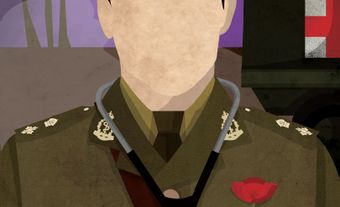The red poppy is a symbol of Remembrance Day that was inspired by the poem “In Flanders Fields,” written by Lieutenant-Colonel John McCrae. Canada officially adopted the poppy as a symbol of remembrance in 1921. Red poppy pins are sold by the Royal Canadian Legion and worn by millions of Canadians in the weeks leading up to and on 11 November.

Red Poppy
The symbol of Remembrance Day is the red poppy, which grows on the First World War battlefields of Flanders (in Belgium) and northern France. The poppy as a symbol of death and renewal predates the First World War and dates back as far as the Napoleonic wars in the 19th century. The seeds of the flower may remain dormant in the earth for years, but they will blossom in abundance when the soil is disturbed. As the artillery barrages began to churn the earth in late 1914, the fields of Flanders and northern France saw scores of red poppies appear.
The first person to use the poppy as a symbol of remembrance was Moina Michael, a member of the American Overseas YMCA, who had been inspired by Lieutenant-Colonel John McCrae’s poem “In Flanders Fields.” Michael pledged “always to wear a red poppy of Flanders Fields as a sign of remembrance and the emblem of ‘keeping the faith with all who died,’” referencing a line in the poem.
McCrae wrote his famous war poem in 1915, at a Canadian dressing station north of Ypres, Belgium, taking his view of the poppy-strewn battlefield as artistic inspiration:
In Flanders fields the poppies blow
Between the crosses, row on row,
That mark our place; and in the sky
The larks, still bravely singing, fly
Scarce heard amid the guns below.
We are the dead: Short days ago,
We lived, felt dawn, saw sunset glow,
Loved and were loved: and now we lie
In Flanders fields!
Take up our quarrel with the foe
To you, from failing hands, we throw
The torch: be yours to hold it high
If ye break faith with us who die,
We shall not sleep, though poppies grow
In Flanders fields.

On 9 November 1918, Michael shared her pledge with her colleagues, who asked to wear poppies along with her. The next day, she purchased 25 silk poppies with money given to her by YMCA employees for her work on a YMCA conference in New York City. She pinned one to her coat collar and gave the rest to her colleagues. Over the years, she worked to popularize the poppy as a symbol of remembrance. The National American Legion adopted the symbol at its conference in April 1920 after hearing Michael’s campaigning.
Anne Guérin of France was inspired by the same campaign. She too had been touched by McCrae’s poem, and became a vigorous advocate of the red poppy. Guérin started the American and French Children’s League, which sold cloth poppies to raise money for people suffering in war-torn France, particularly orphaned children. In 1921, she travelled to Britain and Canada and persuaded both the British Legion and the Canadian Great War Veterans Association (a predecessor of the Royal Canadian Legion) to adopt the poppy as their symbol of remembrance as well.
The veterans’ association chose Jewish-Canadian philanthropist Lillian Freiman to lead the poppy campaign in Canada. Among its patrons were Governor General Byng and his wife, Lady Byng. The first “poppy day” in Canada (and Britain) occurred on 11 November 1921. Millions of poppies were brought to Canada from Guérin’s organization in France. They were supplemented by cloth poppies created by Canadian women, some of whom made the flowers in Freiman’s home in Ottawa. Members of the Imperial Order Daughters of the Empire (IODE) in Winnipeg also made poppies. By 1922, lapel-worn poppies were manufactured and distributed by veterans in Canada. The Royal Canadian Legion, formed in 1925, has run the poppy fundraising campaign in Canada ever since.

Today, millions of Canadians wear the bright red emblem as a symbol of remembrance, leading up to and on 11 November. The Poppy campaign raises funds to support veterans and their families.
In 2021, Canada Post issued a stamp celebrating the 100th anniversary of the poppy’s adoption as a national symbol of remembrance.

White Poppy
Some organizations in Canada, including Canadian Voice of Women for Peace (VOW Peace) and the Vancouver-based Peace Poppies, support the wearing of white poppies instead of, or in addition to, the traditional red version. The white poppy represents a commitment to peace and commemorates all victims of war, most of whom are civilian rather than military. The white poppy has a long history. It was first distributed in the United Kingdom in 1933 by the Women’s Co-operative Guild. Although the white poppy has become more popular in the 21st century, particularly in Britain, many people still oppose its use as they feel it is disrespectful to veterans. This includes the Royal Canadian Legion, which in 2010 threatened legal action against groups distributing white poppies, particularly the Ottawa Poppy Coalition and PEI’s Island Peace Committee.

 Share on Facebook
Share on Facebook Share on X
Share on X Share by Email
Share by Email Share on Google Classroom
Share on Google Classroom




